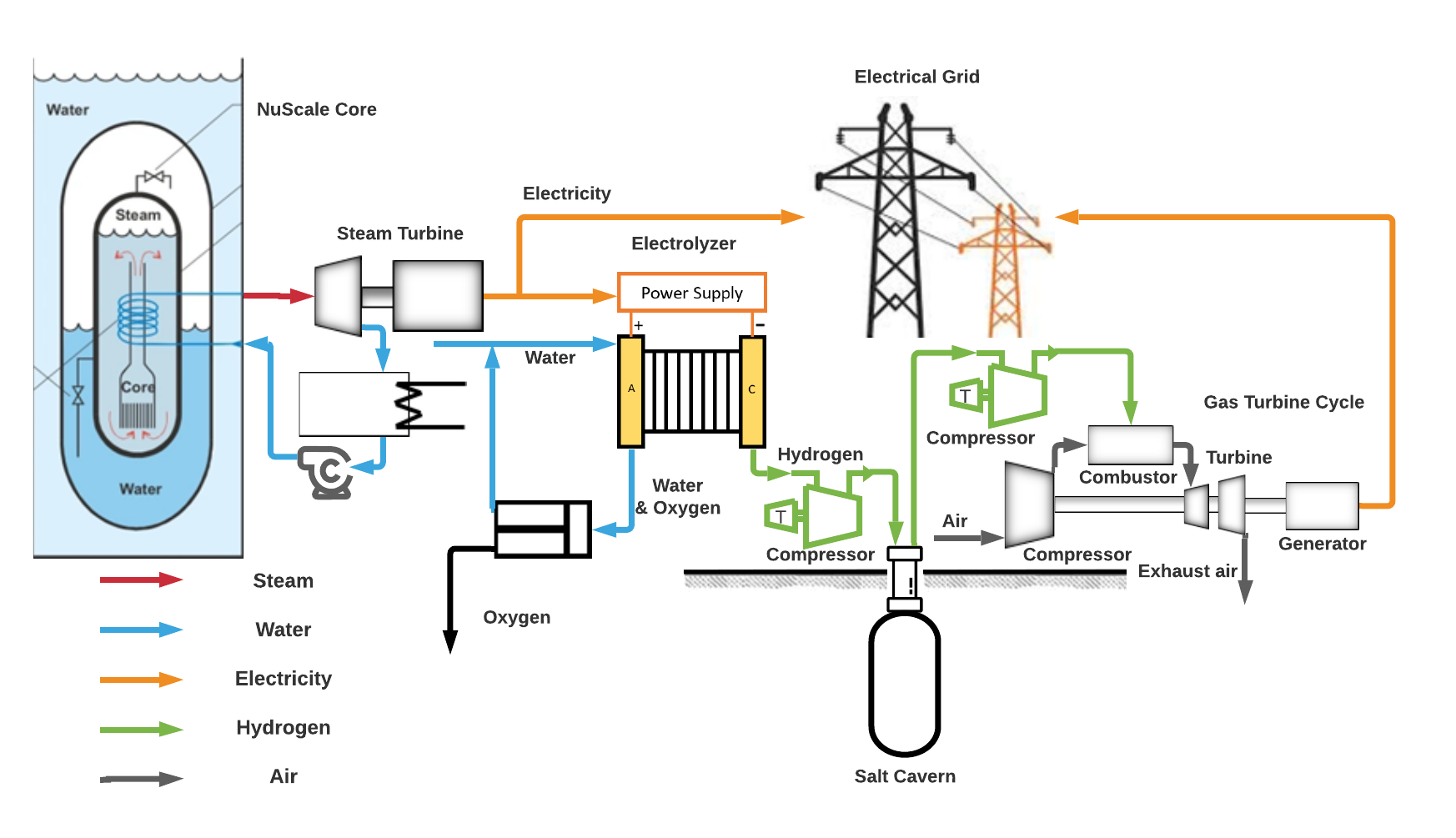To reduce CO2 and other greenhouse gas emission, electricity grids have been transitioning away from fossil fuel sources to more renewable energy sources. However, technical and economic challenges have risen due to the high intermittency, high variability and low-capacity factor of these renewable energy sources [1], [2]. Power systems with high penetration of renewable energy requires higher flexibility at all times to maintain the balance of supply and demand. Traditional load following plants such as natural gas power plants have been used to meet the fluctuations in electricity demand. These power plants emit significant amount of greenhouse gases [3]. To truly work toward a carbon-free future, these traditional plants have to be replaced by other reliable sources of energy such as nuclear power plants [4].
Integrating nuclear power plants with other clean, renewable energy sources has been shown to increase the flexibility and reliability of the grid system [5]. These hybrid systems increase the flexibility of the grid by storing excess energy during low peak periods as heat (thermal energy storage), electricity (batteries), elevation (pumped hydro), or by producing other commodities. This stored energy can then be used to generate additional electricity during high peak periods with relatively low losses from storage.
A novel nuclear-hydrogen hybrid energy system with large-scale storage in a salt-cavern is proposed as a flexible system for load following [6]. The schematic of the hybrid system is shown in Figure 1. The hybrid system integrates a small modular reactor (SMR) module with a steam Rankine cycle, a polymer electrolyte membrane (PEM) electrolyzer, a large-scale hydrogen storage system with an underground salt cavern, and a hydrogen gas turbine cycle. A dynamic mathematical model is developed for each subsystem in Matlab/Simulink.
Figure 1. Schematic diagram of the proposed NHES
To evaluate the technical feasibility as well as the performance of the hybrid system, a one-year simulation is run using scaled real demand data from ISO New England. The demand data is scaled from a regional profile to a demand profile of a city to account for the size of the nuclear reactor (50 MWe). The results show that the hybrid systemâs benefit includes reduced nuclear power plant ramping, increased demand met, increased flexibility, as well as reduced greenhouse gas emission.
Due to the addition of the hydrogen generation plant and the storage element in the salt cavern, the hybrid system is shown to be able to load follow while minimizing the load cycles of the nuclear reactor. The flexibility of the system increases due to the addition of these buffers, and enables the nuclear plant to run at base load 92.6% of the year. The number of ramping cycles is also reduced from 533 to 39, a reduction of 92.7%. This helps reduce the maintenance cost as well as the risk of mechanical and thermal fractures on the fuel and cladding of the plant. The addition of the hydrogen generation plant and the gas turbine cycle helps the system meet the peak demands by producing additional electricity during high peak periods. This enables the hybrid system to meet the demand 93% of the year without the need for other electricity sources, compared to just 73.4% of the year in the case of a stand-alone nuclear plant. This means that the grid is less reliant on other fossil-fuel based sources, reducing the amount of greenhouse gas emissions.
Bibliography
[1] M. Sheha and K. Powell, "Using Real-Time Electricity Prices to Leverage Electrical Energy Storage and Flexible Loads in a Smart Grid Environment Utilizing Machine Learning Techniques," Processes, vol. 7, 2019.
[2] M. Sheha, K. Mohammadi and K. Powell, "Techno-economic analysis of the impact of dynamic electricity prices on solar penetration in a smart grid environment with distributed energy storage," Applied Energy, vol. 282, 2021.
[3] J. S. Kim, K. M. Powell and T. F. Edgar, "Nonlinear Model Predictive Control for a Heavy-Duty as Turbine Power Plant," in American control conference, Washington D.C., 2013.
[4] F. J. Sisternes, J. D. Jenkins and A. Botterud, "The value of energy storage in decarbonizing the electricity sector," Applied Energy, 2016.
[5] J. D. Jenkins, Z. Zhou, R. Ponciroli, R. B. Vilim, F. Ganda, F. de Sisternes and A. Botterud, "The benefits of nuclear flexibility in power system operations with renewable energy," Applied Energy, 2018.
[6] A. Ho, K. Mohammadi, M. Memmott, J. Hedengren and K. M. Powell, "Dynamic simulation of a novel nuclear hybrid energy system with large-scale hydrogen storage in an underground salt cavern," International Journal of Hydrogen Energy, vol. 46, no. 61, pp. 31143-31157, 2021.


